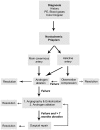A pathophysiology-based approach to the management of early priapism
- PMID: 23202699
- PMCID: PMC3739130
- DOI: 10.1038/aja.2012.83
A pathophysiology-based approach to the management of early priapism
Abstract
Priapism is a rare condition that involves persistent penile erection for greater than 4 h. Distinct variants exist, each with unique characteristics. Ischemic priapism is a painful medical emergency that may occur as a result of veno-occlusion leading to hypoxia and tissue death. Recurrent bouts of ischemic priapism, or stuttering priapism, require treatment for individual attacks as well as long-term prevention. Non-ischemic priapism is associated with trauma and may be managed conservatively. Recent advances into the pathophysiology of priapism have allowed the development of treatment algorithms that specifically target the mechanisms involved. In this review, we outline the basics of smooth muscle contraction and describe how derangement of these pathways results in priapism. A pathophysiological approach to the treatment of priapism is proposed with duration-based algorithms presented to assist in management.
Figures


References
-
- Tripe J. Case of continued priapism. Lancet. 1845;2:8.
-
- Montague DK, Jarow J, Broderick GA, Dmochowski RR, Heaton JP, et al. American Urological Association guideline on the management of priapism. J Urol. 2003;170:1318–24. - PubMed
-
- Broderick GA, Kadioglu A, Bivalacqua TJ, Ghanem H, Nehra A, et al. Priapism: pathogenesis, epidemiology, and management. J Sex Med. 2010;7:476–500. - PubMed
-
- Brant WO, Garcia MM, Bella AJ, Chi T, Lue TF. T-shaped shunt and intracavernous tunneling for prolonged ischemic priapism. J Urol. 2009;181:1699–705. - PubMed

